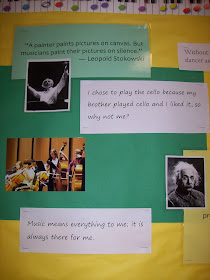When planning out the Solo/Ensemble unit, I work backwards from the date of the festival itself. Since we meet for small groups only once a week, I really have to be mindful of the S/E timeline so students have enough time to prepare.
Saturday: Solo/Ensemble festival
1 week before: Tour day! Students perform for one classroom during their small group time. If there's extra time, we'll go to a second performance site like the office or special education room or music room. Students perform their solo pieces first, and we end with ensembles. Before the school day, I set up chairs for cellists and music stands outside the different classrooms so everything is ready to bring into the classroom for the performance time and all I have to lug around the school is my camera :) To get comment sheets ready for the Saturday festival, I use mail merge on Word to automatically add the headings (student name, piece, school, site, time, etc.) and print them on colored paper by school to enable quick sorting after the event.
2 weeks before: Dress rehearsal day! Students get in front of their small group, say their introduction, and practice playing through their piece(s) without stopping. I jot down final comments to help during their last week of home practice. I do not want tour day to be the first time students are up in front of an audience playing through their piece. I want them to get their jitters out of the way during dress rehearsal day and to make sure everyone has their introduction planned out. Any late S/E signups should all be in, so I put together the Saturday morning schedule and share that with students and families.
3-4 weeks before: Rehearse! During small groups, a big chunk of time is dedicated to rehearsing with students' ensemble groups. Students also figure out what they're going to say for their introduction, using the introduction template as a guide. I also send out a tour sign-up sheet (using Google Sheet) where teachers can choose a time that works best for them to have students come perform for their class.
5-6 (or so) weeks before: The last 5-10 minutes of small groups are dedicated to practicing individual parts of S/E pieces. I quickly go around helping students--especially in the area of rhythm--to hopefully make the first combined rehearsal with their ensemble go smoothly. The warm-up for each of these weeks gets a different emphasis, based on the different categories on the S/E rubric: rhythm, LH, RH, etc. This is the time when I tell students about the Saturday morning optional festival and send home the sign-up sheet for that. I remind students that everyone will go on tour during school, and then the S/E festival on that Saturday morning is a highly encouraged optional event. We briefly look over the rubric to see which areas the adjudicator would be commenting on.
- Letter/permission slip sample (Word document)
- Letter/permission slip sample (PDF)
- Online registration form template (Google Form)
- Rubric (Word document)
- Rubric (PDF)
- Updated rubric (Word document)--includes a category for body format instead of tone
- Updated rubric (PDF)
2nd week of unit: During full orchestra, students form their ensembles and fill out a planning sheet, indicating which piece(s) they're planning to learn. Every student turns one in, and there's a place to list a solo piece and an ensemble piece plus who is in their group. I type these up into one master list for myself to make sure everyone is accounted for. I talk with those students who signed up for just a solo to see if they also had an interest in playing in an ensemble and help set that up if desired. Repertoire choices may change over the next few weeks, but at least everyone is leaving class that day with an idea of which piece(s) to focus their home practice on.
1st week of unit: Explain what Solo/Ensemble is, hand out the list of choices plus additional repertoire, and give some time to try out options. I tell students that at the end of this unit we will be going on tour around school to perform our piece(s) for an audience.
This timeline covers roughly two months of school. During this time--especially at the beginning of the unit--we are focused on more than just Solo/Ensemble in orchestra, and this advance planning helps me to balance all different areas of what students are learning during this time.
See also:






















